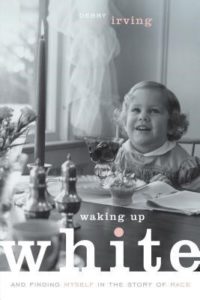A Reflection on Waking Up White, by Debby Irving
by Renewal Steering Committee Member Kay Roush
Have you read the book, Waking Up White and Finding Myself in the Story of Race, by Debby Irving? This is an eye-opening book so relevant to our Renewal 2017. A copy is shelved on our church library cart.
Irving claimed she didn’t have a racist bone in her body. She had chosen to live in a diverse community, had spent 25 years working with different cultural groups and with those in the Black underserved community. She thought of herself as a good person.
As years passed she became more disturbed by racial divides. Her concerns finally led her to work on a Master’s Degree at Wheelock College in Boston. The first class Irving took was “Racial and Cultural Identity.” It changed her thinking. “Racism wasn’t about this person or that, this upset or that, this community or that, racism is and always has been, the way America has sorted and ranked its people in a bitterly divisive, humanity-robbing system.”
Her book gives numerous down-to-earth explanations. A few examples are: Irving points out that Whites put the indigenous people of America on reservations, introduced them to alcohol and then called them drunks. Federal programs were instigated to rob them of their language, customs and beliefs, and called them savages. Additionally, Blacks were enslaved. There was a short respite after the Civil War, then came the Jim Crow laws that enforced racial segregation and the separate but equal treatment that wasn’t equal at all.
The GI Bill, following WWII, allowed returning servicemen to obtain a college education and buy a home with low mortgages. This was great for Whites, but only 4% of Black veterans were able to take advantage of the GI Bill. Too many schools would not admit them, realtors would not sell to them except in rundown areas. It was an unjust system.
Debby Irving included many stories in her book Waking Up White that demonstrate the huge advantages Whites have and people of color do not have. Growing up and living in the ‘White world’ lets Whites believe their way is normal, the way it is for most people in the U.S. Irving also conveys how this world is so different for people of color:
A black woman went into a shop. When she took her items to the cashier they wouldn’t accept her check. She left to return home to get cash. Her white husband asked her why she was leaving again. She explained the situation. He told her that store clerk had always taken his checks. “It wasn’t the bank account but the color of the handwriting the check that mattered.”
 Irving tells about viewing, a few years ago on ABC, an investigative report that highlights White advantages. In it the viewer was introduces to two young men, John was White and Glenn was Black. Both dressed alike, were the same age and college educated. They were sent to St. Louis with hidden cameras. Their charge was to separately buy clothes, find an apartment, buy a used car and get a job.
Irving tells about viewing, a few years ago on ABC, an investigative report that highlights White advantages. In it the viewer was introduces to two young men, John was White and Glenn was Black. Both dressed alike, were the same age and college educated. They were sent to St. Louis with hidden cameras. Their charge was to separately buy clothes, find an apartment, buy a used car and get a job.
The treatment they received was quite different. John felt welcomed at the stores, helped at the employment office, was offered a car for less money then Glenn was quoted, and could easily rent an apartment. Glenn was ignored in the same stores, warned by the employment office to not mess up, was quoted a higher price for the same car, and was turned away from the apartment that John then rented soon afterward.
The author viewed this report in 2010 with a racially mixed group. She noted that those of color indicated how familiar these incidences were for them. The Whites in the audience could not believe that such different treatment really happened. It is so hard to see and understand White privilege. Currently the Black and brown people in Ferguson, after Michael Brown’s death, have been trying to tell how it really is as they work for racial justice.
Waking Up White can help a reader be more aware of White privilege and how it affects our lives, as well as, the lives of people of color.

